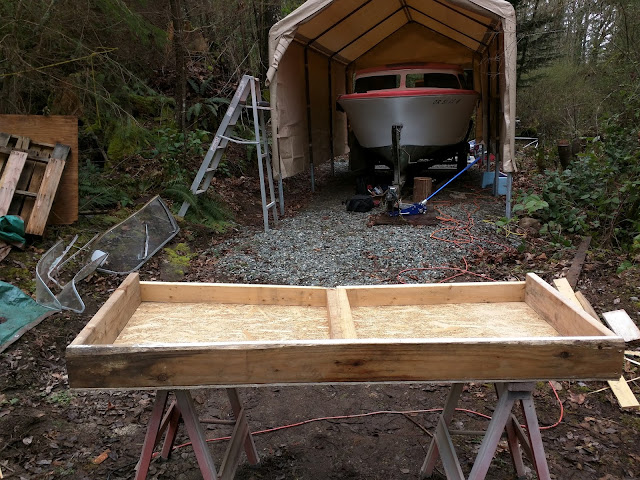Trailer
It took some doing, but
the trailer is free of the boat.
The following steps were
involved:
1.
- Lower the trailer
tongue to raise the stern
2.
- Build a cradle to
support the stern
3.
- Raise the tongue and
pull the trailer out from underneath
o tie the transom to a tree conveniently located
about 20' behind the boat
o jack up and block the bow of the boat
o slowly pull the boat forward until the bow
cribbing meets a trailer crossmember
o repeat until the trailer is about halfway out
4.
Build another cradle a
bit aft of amidships
o Repeat above until the trailer is nearly free of
the boat
5.
Block up the keel near
the bow
The numbers and bullets
make it sound easy, but it was tedious and a bit nerve-wracking. Here is the
story in pictures:
|
|
Cradle for the stern. Sheathed in
1/2" OSB for shear strength. I made a template with craft paper to get
maximum contact along the breadth of the hull bottom.
|
|
|
Rope tied to the very strong
transom and tensioned (note the 1X2 to the left of the stepladder that I used
to twist the rope then brace it to the ground). This is an old halyard off
our last sailboat, with very low stretch.
|
|
|
Bow
blocked while inching the trailer forward. This gap in the trailer
cross-members here is about 2'; the gaps behind it are about half that, which
means lots of re-blocking and jacking. Did I mention tedious?
|
 |
| This shows the cradles at the stern and slightly behind amidships, then the keel blocked up about 5' behind the bow. Note the 2X4 between the two cradles to provide fore and aft stability. |
The main complication in
this process involved the giant side bunks on the trailer. They were so tight
against the hull that the trailer had to be pulled straight out with respect to
the boat or even the stout ropes would not keep the boat immobile. I couldn't
pull the boat straight out with the pickup because of limited space to
maneuver, so ended up using a come-along affixed to the pickup parked straight
ahead of the trailer. This worked great, since it was easy to control and I could
clearly see what was going on...much better than monitoring things through the
side mirror.
So, the trailer is out
and today I finished scraping off the worst of the rust then pressure washed
it. Although it is old and looks like crap, it is well constructed and
structurally sound. The weather later this week should allow for painting. This
will involve applying a reducer to change the ferric iron (rust) into ferrous
(the normal iron state), then slapping on a coat of Rust-Oleum paint. I'm under
no illusions that it won't rust again, probably beginning shortly after the
Offshore is launched in salt water, but there is a lot of metal left so it
should last for many a year. I'll try to wash it off with fresh water after
dunking it, but that is not always available at boat launches.
My friend Bruce B. helped with painting the trailer in mid-April, after I reduced the rust using a product from Rodda. After that I painted the wheels, installed new bearings, races, and seals in the hubs, and had new tires mounted. I contemplated upsizing the 13" wheels to 14", but wasn't sure the tires would clear the fenders with a loaded boat on the trailer, so stayed with the original set-up. I then packed the bearings, filled the hubs with marine grease, and pumped up the Bearing Buddies. That took almost a full tube!
 |
| Painted trailer. |
 |
| Lights on! |
 |
| The rear view, with the special three lights in the center required for trailers >80" |
Today (5/10/2018) I drove the trailer to the nearest WSP inspection station near the Bellingham airport, after setting up an appointment two weeks ago. I had some trepidation with this: would they evaluate the structural integrity of the trailer, or did I get the lighting wrong? The inspection was anticlimactic. They measured the trailer, stamped the new VIN on, and called it good. They didn't even ask me to turn on the lights, for goodness sake!
 |
| A legal trailer! |
Later today I went to the Anacortes licensing office to finally transfer the title for the boat and trailer and get a license plate for the trailer. My new friend Crystal Johnson there was able to correct the Oregon title to reality. It had the Offshore as built in 1960, and a weird hull number of five numbers. I was able to pull up a picture of the original hull plate (which was painted over and scratched, and I restored a few months ago) on my phone and send it to her, so the new title is accurate.
 |
| Trailer done, finally. |








Coming right along! It is going to be a beauty!
ReplyDelete(Looks like a homeless camp - good grub there?)
On 2nd thought I guess it looks more like a man cave.
ReplyDeleteWait - a giant secret bread baking place! Say - how will that trailer go back under?
ReplyDelete